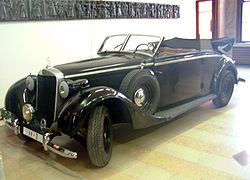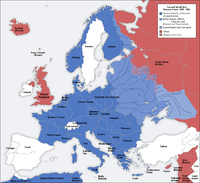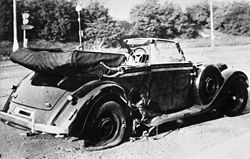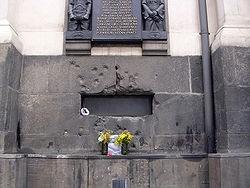- Operation Anthropoid
-
Operation Anthropoid was the code name for the targeted killing of top German SS leader Reinhard Heydrich.[1] He was the chief of the Reich Main Security Office (Reichssicherheitshauptamt, or RSHA), the acting Protector of Bohemia and Moravia, and a chief planner of the Final Solution, the Nazi German programme for the genocide of the Jews of Europe.
Contents
Reinhard Heydrich
Heydrich was a SS-Obergruppenführer and General der Polizei who had been the chief of the RSHA since September 1939. This was an organisation that included the Secret State Police (Gestapo), the Security Service (Sicherheitsdienst, or SD), and the Criminal Police (Kripo).[2] In August 1940, Heydrich became the President of the International Criminal Police Organisation (Interpol). Heydrich was a key planner in eliminating Hitler’s opponents, as well as (later) the key planner of the genocide of the Jews. He was involved in most of Hitler’s intrigues and a valued political ally, adviser and friend of the dictator.
In September 1941, Heydrich was appointed acting Protector of Bohemia and Moravia, replacing Konstantin von Neurath. Hitler agreed with Heinrich Himmler and Heydrich that von Neurath's "soft approach" to the Czechs promoted anti-German sentiment, and encouraged anti-German resistance by strikes and sabotage.[3] Heydrich came to Prague to "strengthen policy, carry out counter measures against resistance" and keep up production quotas of Czech motor and arms that were "extremely important to the German war effort".[3] During his role as de facto dictator of Bohemia and Moravia, Heydrich often drove with his chauffeur in a car with an open roof. This was a show of his confidence in the occupation forces and in the effectiveness of his government.[4] Due to his brutal efficiency, Heydrich was nicknamed the Butcher of Prague, the Blond Beast, and the Hangman.
Strategic context
By late 1941, Hitler controlled almost all continental Europe, and German forces were approaching Moscow.[5] The Allies deemed Soviet capitulation likely. The exiled government of Czechoslovakia, under President Edvard Beneš, was under pressure from British intelligence, as there had been very little visible resistance since the occupation of the Sudeten regions of the country in 1938 (occupation of the whole country began in 1939). The takeover of these regions that was enforced by the Munich Agreement and the subsequent terror of the German Reich broke the will of the Czechs for a period.
While in several other countries defeated in open warfare (e.g. Poland, Yugoslavia and Greece) the resistance was active from the very beginning of occupation, the subdued Czech lands remained relatively calm, simultaneously producing significant amounts of military material for the Third Reich. The exiled government felt it had to do something that would inspire the Czechs, as well as show the world the Czechs were allies.
The status of Reinhard Heydrich as the Protector of Bohemia and Moravia as well as his reputation for terrorizing local citizens led to him being chosen over Karl Hermann Frank as an assassination target. The operation was also meant to prove to the Nazis that they were not untouchable.[1]
Operation
Planning
The operation was given the codename "Anthropoid". With the British Special Operations Executive (SOE), preparation began on October 20, 1941. Warrant Officer Jozef Gabčík and Staff Sergeant Karel Svoboda were chosen to carry out the operation on October 28, 1941 (Czechoslovakia's Independence Day).[1] Svoboda was replaced with Jan Kubiš after a head injury during training, causing delays in the mission, as Kubiš had not completed training nor had the necessary false documents been prepared for him.[6]
Insertion
Jozef Gabčík and Jan Kubiš were airlifted along with seven soldiers from Czechoslovakia’s army-in-exile in the United Kingdom and two other groups named Silver A and Silver B (who had different missions) by a Royal Air Force Halifax of No. 138 Squadron into Czechoslovakia at 10pm on December 28, 1941. Gabčík and Kubiš landed near Nehvizdy east of Prague; although the plan was to land near Pilsen, the pilots had problems with orientation.[7] The soldiers then moved to Pilsen to contact their allies, and from there on to Prague, where the attack was planned.
In Prague, they contacted several families and anti-Nazi organisations who helped them during the preparations for the targeted kill.[8] Gabčík and Kubiš initially planned to kill Heydrich on a train, but after examination of the logistics, they realised that this was not possible. The second plan was to kill him on the road in the forest on the way from Heydrich’s seat to Prague. They planned to pull a cable across the road that would stop Heydrich’s car but, after waiting several hours, their commander, Lt. Adolf Opálka (from the group Out Distance), came to bring them back to Prague. The third plan was to kill Heydrich in Prague.
The attack in Prague
 Another of Heydrich's Mercedes 320 Convertible B cars, similar to the one in which he was mortally wounded (currently in the Military History Museum in Prague)
Another of Heydrich's Mercedes 320 Convertible B cars, similar to the one in which he was mortally wounded (currently in the Military History Museum in Prague)
On May 27, 1942, at 10:30 AM, Heydrich proceeded on his daily commute from his home in Panenské Břežany to Prague Castle. Gabčík and Kubiš waited at the tram stop on the curve near Bulovka Hospital in Prague 8-Libeň. Valčik was positioned about 100 metres north of Gabčík and Kubiš as lookout for the approaching car. As Heydrich’s open-topped Mercedes-Benz neared the pair, Gabčík stepped in front of the vehicle, trying to open fire, but his Sten gun jammed. Heydrich ordered his driver, SS-Oberscharführer Klein, to stop the car. When Heydrich stood up to try to shoot Gabčík, Kubiš threw a modified anti-tank grenade[9] at the vehicle, and its fragments ripped through the car’s right-rear fender, embedding shrapnel and fibres from the upholstery into Heydrich’s body, even though the grenade failed to enter the car. Kubiš was also injured by the shrapnel. Heydrich, apparently unaware of his shrapnel injuries, got out of the car, returned fire and tried to chase Gabčík but soon collapsed. Klein returned from his abortive attempt to chase Kubiš, and Heydrich ordered him to chase Gabčík. Klein was shot twice by Gabčík (who was now using his revolver) and wounded in the pursuit.[10][11] The soldiers were initially convinced that the attack had failed.
Medical treatment and death
Heydrich was taken to Bulovka Hospital, 250 m away. There he was operated on by Professor Hollbaum, a Silesian German who was chairman of surgery at Charles University in Prague, assisted by Dr. W. Dick, the Sudeten German chief of surgery at the hospital.[12] The surgeons reinflated the collapsed left lung, removed the tip of the fractured eleventh rib, sutured the torn diaphragm, inserted several catheters and removed the spleen, which contained a grenade fragment and upholstery material.[12] The surgery lasted an hour and went uneventfully. Heydrich’s direct superior, Reichsführer-SS Heinrich Himmler, sent his personal physician, Karl Gebhardt, who arrived that evening. After May 29, Heydrich was entirely in the care of SS physicians. Postoperative care included administration of large amounts of morphine. There are contradictory accounts concerning whether sulfanilamides were given, but Gebhardt testified at his 1947 war crimes trial that they were not.[12] The patient developed a fever of 38-39 °C and wound drainage. After seven days, his condition appeared to be improving when, while sitting up eating a noon meal, he collapsed and went into shock, dying the next morning.[12] Himmler’s physicians officially described the cause of death as septicaemia, meaning infection of the bloodstream.[13] One of the theories was that some of the horsehair used in the upholstery of Heydrich’s car was forced into his body by the blast of the grenade, causing a systemic infection.[14] It has also been suggested that he died of a cerebral or pulmonary embolism.[12]
Botulinum poisoning theory
The authors of A Higher Form of Killing claim that Heydrich died from botulism; i.e. botulinum poisoning.[15] According to this theory, the Type 73 hand anti-armour grenade which was used in the attack, had been modified to contain botulinum toxin. This story originates from comments made by Paul Fildes, a Porton Down botulism researcher. However, there is only circumstantial evidence to support this allegation[12][16] (the records of the SOE for the period have remained sealed). This allegation remains unverified, as Fildes' comments are merely hearsay and few medical records of Heydrich's collapse have been preserved.[12]
The general evidence cited to support the theory includes the curious modifications made to the Type 73 grenade: the upper third part of this British anti-tank grenade had been removed and the open end and sides wrapped up with tape. A specially modified weapon could be explained by the need to attach a toxic or biological payload. In addition, Heydrich received excellent medical care by the standards of the time. His autopsy showed none of the usual signs of septicaemia, although infection of the wound and areas surrounding the lungs and heart was reported.[12] The authors of a German wartime report on the incident stated that "Death occurred as a consequence of lesions in the vital parenchymatous organs caused by bacteria and possibly by poisons carried into them by bomb splinters...".
Heydrich's progression to death was not recorded in detail, but he appears to have died due to cardiac arrest, rather than from respiratory failure as is typical with botulinum poisoning. Also, it is worth noting that two other people were wounded by fragments of the same grenade: Kubiš, the Czech soldier who threw the grenade, and a bystander. Neither Heydrich nor these two others are recorded to have displayed any of the usual paralytic or other symptoms associated with botulism.[12][17] Given that Fildes is reported to have had a tendency to make "extravagant boasts", and that the grenade modifications could have been simply aimed at making it lighter, the validity of the botulinum toxin theory has been questioned.[12]
Consequences
Reprisals
Hitler ordered the SS and Gestapo to “wade in blood” throughout Bohemia to find Heydrich’s killers. Hitler wanted to start with brutal, widespread killing of the Czech people but, after consultation, he reduced his directive to only several thousand. The Czech lands were an important industrial zone for the German military and indiscriminate killing could reduce the productivity of the region.
More than 13,000 people were ultimately arrested, including the girlfriend of Jan Kubiš, Anna Malinová, who died at Mauthausen-Gusen concentration camp. First Lieutenant Adolf Opálka's aunt, Marie Opálková, was executed in Mauthausen on 24 October 1942.[18] His father, Viktor Jarolím, was also killed.[19]
Lidice
The most notorious incident was in the village of Lidice, which was destroyed on June 9, 1942: 199 men were executed, 95 children taken, 8 of whom were taken for adoption by German families, and 195 women arrested.[20]
The possibility that the Germans would apply the principle of "collective responsibility" on this scale in avenging Heydrich's assassination was either not foreseen by the Czech government-in-exile or else was deemed an acceptable cost to pay for eliminating Heydrich and provoking reprisals that would reduce Czech acquiescence to the German administration.
Britain’s wartime leader Winston Churchill, infuriated, suggested leveling three German villages for every Czech village the Nazis destroyed. Two years after Heydrich's death they planned one more attempt, this time targeting Hitler in Operation Foxley, but failed to obtain approval. Operation Anthropoid remains the only targeted killing of a top-ranking Nazi, although the Polish underground killed two senior SS officers in the General government (see Operation Kutschera and Operation Bürkl) and General-Kommissar of Belarus Wilhelm Kube was killed by a Belarusian woman.
Attempted capture of the soldiers
The attackers initially hid with two Prague families and later took refuge in Karel Boromejsky Church, an Orthodox church dedicated to Saints Cyril and Methodius in Prague. The Germans were unable to locate the attackers until Karel Čurda of the "Out Distance" sabotage group was arrested by the Gestapo and gave the names of the team’s local contacts[21] for the bounty of 0.5 million Reichsmarks.
Čurda betrayed several safe houses provided by the Jindra group, including that of the Moravec family in Žižkov. At 5.00 am on June 17, the Moravec flat was raided. The family was made to stand in the corridor while the Gestapo searched their flat. Mrs. Moravec was allowed to go to the toilet, and killed herself with a cyanide capsule. Mr. Moravec, oblivious to his family's involvement with the resistance, was taken to the Peček Palác together with his son Ata. Ata was tortured throughout the day. Finally, he was stupefied with brandy and shown his mother's severed head in a fish tank.[22] Ata Moravec told the Gestapo what they wanted to know.
SS troops laid siege to the church but, despite the best efforts of over 700 German soldiers, they were unable to take the paratroopers alive; three, including Kubiš, were killed in the prayer loft (Kubiš was said to have survived the battle, but died shortly afterward from his injuries) after a 2-hour gun battle.[23] The other four, including Gabčík, committed suicide in the crypt after fending off SS attacks, attempts to smoke them out, and fire trucks being brought in to try to flood the crypt.[24] The Germans (SS and police) also had casualties, allegedly 14 SS killed and 21 wounded.[25][26] The official SS report about the fight mentions five wounded SS soldiers.[27] The men in the church had small calibre pistols, while the attackers had submachine guns, machine guns and hand grenades.
Bishop Gorazd, in an attempt to minimize the reprisals among his flock, took the blame for the actions in the church on himself, even writing letters to the Nazi authorities. On June 27, 1942, he was arrested and tortured. On September 4, 1942, he, the church's priests, and senior lay leaders were executed by firing squad. (For his actions, Bishop Gorazd was later glorified as a martyr by the Eastern Orthodox Church).
Political consequence and aftermath
The success of the operation made Great Britain and France renounce the Munich Agreement. They agreed that after the Nazis were defeated the Sudetenland would be restored to Czechoslovakia. It also led to sympathy for the idea of expelling the German population of Czechoslovakia[citation needed].
As Heydrich was one of the most important Nazi leaders, two large funeral ceremonies were conducted. One was in Prague, where the way to Prague Castle was lined by thousands of SS-men with torches. The second was in Berlin attended by all leading Nazi figures, including Hitler who placed the German Order and Blood Order medals on the funeral pillow.
Karel Čurda, after attempting suicide, was hanged in 1947 for high treason.[28][29]
Memorials
The Slovak National Museum opened an exhibition in May, 2007 to commemorate the heroes of the Czech and Slovak resistance, presenting one of the most important resistance actions in the whole of German-occupied Europe. There is a small fountain in the Jephson Gardens, Leamington Spa (one of the places where the Czech Free Army were based) commemorating the bravery of the troops.
The Anthropoid Operation Memorial, 2009, Prague, authors: sculptor David Mojescik MojDa and sculptor Michal Smeral, architects — M. Tumova and J. Gulbis. More informations here.
Portrayals
Operation Anthropoid was the basis for the 1943 films Hangmen Also Die and Hitler's Madman, the 1964 film Atentat, and the 1975 film Operation Daybreak.
It is also the subject of the 1960 book Seven Men at Daybreak by Alan Burgess, the 1989 history The Killing of SS Obergruppenfuhrer Reinhard Heydrich by Callum MacDonald and the 2010 Prix Goncourt-winning novel "HHhH" by Laurent Binet.
See also
- Czech resistance to Nazi occupation
- Occupation of Czechoslovakia
- Operation Foxley - SOE plot to kill Adolf Hitler in 1944
- Operation Kutschera - Polish assassination of the SS and Police Leader Franz Kutschera in 1944
- List of Nazi Party leaders and officials
- List of rulers of the Protectorate Bohemia and Moravia
References
- Burian, Michal; Aleš (2002). "Assassination — Operation Arthropoid, 1941-1942" (PDF). Ministry of Defence of the Czech Republic. http://www.army.cz/images/id_7001_8000/7419/assassination-en.pdf. Retrieved 20 May 2010.
- ^ a b c Burian et al 2002, p. 31
- ^ Lumsden, Robin. A Collector's Guide To: The Allgemeine — SS, p 83.
- ^ a b Williams, Max. Reinhard Heydrich: The Biography: Volume 2, p 82.
- ^ Williams, Max. Reinhard Heydrich: The Biography: Volume 2, p 141.
- ^ Shepherd, Ammon (2008). "World War II — Timeline". http://gmu.mossiso.com/689/?p=timeline. Retrieved 2008-07-07.
- ^ Burian et al 2002, p. 35
- ^ Burian et al 2002, p. 44
- ^ Burian et al 2002, pp. 48 – 49
- ^ Michel, Wolfgang, Britische Spezialwaffen 1939-1945: Ausrüstung für Eliteeinheiten, Geheimdienst und Widerstand, p. 72. ISBN 3-842-33944-5
- ^ Burgess, Alan, Seven Men At Daybreak, p. 160. ISBN 0-553-23508-7
- ^ Burian et al 2002, p. 64
- ^ a b c d e f g h i j Defalque, R. J.; Wright, A. J. (January 2009). "The Puzzling Death of Reinhard Heydrich". Bulletin of Anesthesia History (Pittsburgh PA: Anesthesia History Assoaciation and Wood-Library Museum of Anesthesiology) 27 (1): 1–7. http://www.anesthesia.wisc.edu/AHA/Bulletin/January_2009.pdf. Retrieved 2009-05-29.
- ^ Burian et al 2002, p. 65
- ^ MacDonald, Callum (1998). The Killing of Reinhard Heydrich: The SS "Butcher of Prague". Da Capo Press. pp. 182–183. ISBN 0306808609. http://books.google.com/?id=idNQLCHiO7cC. Retrieved 2009-05-28.
- ^ Harris, Robert; Paxman, Jeremy (1982). A Higher Form of Killing: The Secret History of Chemical and Biological Warfare. London: Chatto & Windus. pp. 336 (see chapter 4, pp. 70–108). ISBN 978-0812966534. OCLC 8261705. http://books.google.com/books?id=MxV_86EpdRIC&printsec=frontcover.
- ^ Carus, W. Seth (2001). Bioterrorism and Biocrimes: The Illicit Use of Biological Agents Since 1900. The Minerva Group, Inc. p. 89. ISBN 1410100235. http://books.google.com/?id=1jEP8Ve4zwgC.
- ^ Middlebrook and Franz (1998). BOTULINUM TOXINS. Office of The Surgeon General, Department of the Army, United States of America. http://www.au.af.mil/au/awc/awcgate/medaspec/Ch-33Rprntblscx699.pdf.
- ^ http://www.vets.estranky.cz/clanky/vpm-okres-znojmo/resice
- ^ http://www.vets.estranky.cz/clanky/vpm-okres-znojmo/vemyslice
- ^ MacDonald, Callum. The Killing of Reinhard Heydrich: The SS "Butcher of Prague". pp. 186, 187. ISBN 0306808609.
- ^ "The Assassination of Reinhard Heydrich", The Holocaust Education & Archive Research Team
- ^ McDonald, Callum, The Killing of Reinhard Heydrich: The SS “Butcher of Prague”, p. 202. ISBN 0-306-80860-9
- ^ McDonald, Callum, The Killing of Reinhard Heydrich: The SS “Butcher of Prague”. ISBN 0-306-80860-9
- ^ Burgess, Alan, Seven Men At Daybreak. ISBN 0-553-23508-7
- ^ Axis History Forum • View topic - Last fight of Heydrich's killers
- ^ Cowdery, Ray R. & Vodenka, Peter, Reinhard Heydrich: Assassination. Victory WW2 Publishing Ltd. (1994) Lakeville, MN, USA
- ^ Karl von Treuenfeld: Report about the employment of [[Waffen-SS 23 June 1942] (in Czech translation)
- ^ 'Czech Traitors Hanged Today", 1947, The Free Lance-Star
- ^ "Trial and terror in a by-gone Prague", 2007, The Telegraph
External links
- National Memorial to the Heroes of the Heydrich Terror
- Radio Prague: Czechs in World War II
- Radio Prague: Exhibitions mark 60th anniversary of assassination of Nazi governor Heydrich
- Operation Anthropoid at Everything2
- Czechs in Exile website
- Exhibition on Operation Anthropoid at the Slovak Nation Museum
- The Prague Daily Monitor: Experts find wartime paratroopers' grave
Coordinates: 50°07′06″N 14°27′53″E / 50.11833°N 14.46472°E
Categories:- Conflicts in 1942
- 1942 in Czechoslovakia
- Czech resistance to Nazi occupation
- History of Prague
- Special Operations Executive
- World War II operations and battles of Europe
- Assassinations
- Code names
- Military operations of World War II involving Germany
- Battles and operations of World War II involving Czechoslovakia
Wikimedia Foundation. 2010.






